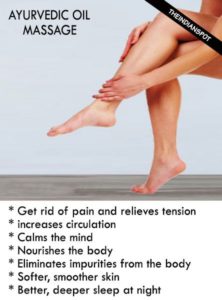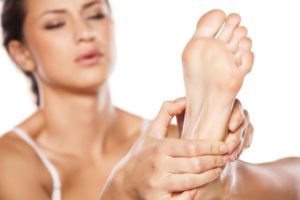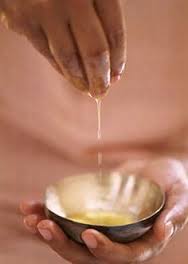Ayurvedic medicine teaches us about self-care, how to create and sustain a healthy body and mind. Pronounced (eye-your-Veda) – Ayurveda is the ancient science of life from India. “Ayur” means “life” and “Veda” translates to “science, knowledge or wisdom.” Ayurveda is a 7,000-year old science of life. It is ancient, yet its principles are as applicable today as they were in so many years ago.
Contents:
- About Ayurveda a brief description
- Some of Ayurveda’s healing modalities.
- Daily routine, Dina Charia
- How to give Abhyanga, self-oil massage.
The 3 goals of Ayurveda are:
- To prevent disease.
- Preserve health.
- Promote longevity.
4 healing modalities:
- Mindful eating: Your diet is one of the most common ways to implement Ayurvedic principles for self-healing. It is an easy way to introduce the beneficial qualities of healing foods into your system since we all tend to eat two to three times per day. * Click here to view or print out Food guidelines for the three constitutional types.
- Pancha Karma. This is a very quick way to eliminate toxins and create balance in the body and mind.
- Ayurveda body treatments. Treatments help to balance the bodily humors/doshas, open the body, and they eliminate pain and energetic blockages.
- Yoga: Yoga practice is an important aspect of healthy living in Ayurveda. In ancient times, people were taught yoga on a one-to-one basis in order to address their individual needs. Group classes are beneficial, and it’s always a good idea to get an Ayurvedic assessment of both your current yoga practice and your needs according to Ayurveda. When you have a practice that serves your precise needs and evolve it over time, you will feel your best.
Ayurveda recognizes that there are 5 basic elements that comprise everything we know. They are, in order from subtle to gross: space, air, fire, water, and earth. Each one of us is a combination of these 5 elements, and 3 doshas or body/mind types.
3 body/mind types.
They are Vata (wind), which governs movement. Pitta (bile), which governs transformation. Kapha (phlegm/mucous), which governs structure. Like a grand cosmic recipe, we are all a combination of each general body/mind type. Traditionally Pancha Karma, a cleansing and rejuvenation program, is very effective in eliminating excesses of Vata, Pitta, and Kapha
Our basic, constitution remains unaltered throughout our life and is called “prakruti.”
Pronounced “pra-krooti,” it is determined the moment the father’s sperm meets the mother’s egg. After that point, we acquire “vikruti” — disorder or departure from order. Vikruti frequently occurs in the junction between seasons or during stressful times.
Each season we can grow in health and Ayurveda teaches us how.
Winter: During the winter months, Kapha (phlegm) accumulates as a result of the cold, damp, cloudy and heavy qualities of the weather. As we move into spring and the temperature rises, Kapha begins to liquefy and becomes increased. This happens at the main Kapha sites, which are; the stomach, chest, sinuses, and nose. This explains the predictable yearly spring allergies, colds, and flu that many people are afflicted with during the season. Click here for more seasonal tips.
Spring: As a result of the excess Kapha, the digestive fire “Agni” is reduced. This is why during the spring (and if you know that your Kapha is prone to increase) it is important to make Kapha pacifying food and lifestyle choices. This would include foods that are lighter in both quality and quantity, drier, warmer and rougher. You may want to include Neti to clear the brain fog that happens. Click here for more seasonal tips.
Summer: In the heat of the summer, Pitta (bile) is increased. As a result, you may see common symptoms such as inflammation, diarrhea and skin rashes. People with Pitta constitution should follow a Pitta pacifying food routine during the summertime. Click here for more seasonal tips.
Fall: Fall is the season that Vata (wind) increases which means dryness and movement in the body also increase. The seat or home of Vata is the pelvis. If you experience tightness here, it is an indication that the qualities of Vata have lodged there. The fall season is a great time to practice Abhyanga, which you will learn below. Click here for more seasonal tips.
Your lifestyle choices may change based on these seasonal routines. Therefore, you may want to make food choices appropriate for the climate, season and body/ mind type. Consider changing the times you choose to eat and sleep; there are even seasons where it is advised that sex is practiced more or less. Other suggestions involve herbs, color, and yoga. Ask us about it during your retreat at The Ayurvedic Center of Hawaii.

Daily Routine
Keeping a daily routine is a discipline, yet it creates such stability in an ever-changing world. Daily routine or exquisite self-care enhances health balances your rhythms along with nature’s rhythms and prevents disease.
An ideal daily routine might look like this:
- Arise before or at sunrise.
- Move your bowels and bladder — fluid intake helps this via the gastro-colic reflex.
- Use abyanga oil massage, nasal administration (optional).
- Exercise (some will consider this more appropriate after meditation, but before breakfast).
- Shower and personal hygiene like cleaning tongue, clipping nails, brushing teeth.
- Practice yoga asanas, yogic breathing, and meditation.
- Eat a light breakfast (optional).
- The main activity of day — giving emphasis to the most physical aspects when possible.
- Eat your main meal at noon.
- Take a short walk.
- Continue day’s activity with emphasis on mental rather than physical aspects.
- Eat a lighter and smaller evening meal.
- Take a short walk.
- Wind down, choose a soothing and calm activity. Such as reading and family discussions or other bonding activities. Generally, watching TV is sometimes too stimulating for evening viewing.
- In bed before 10 PM.
 Abhyanga, Self Oil Massage, Exquisite Self Care
Abhyanga, Self Oil Massage, Exquisite Self Care
click here to view and print out Abhyanga, self-oil massage handout
How can a ritual so luxuriously relaxing, so blissfully comforting as a full-body warm oil massage rev up your body and mind, gearing them up for peak performance? There is an explanation for the seeming contradiction. Accumulated stress and toxins in the mind and body dissolve during the daily massage. A daily full-body warm oil massage, therefore, acts as a powerful recharger and rejuvenator of mind and body.
“Abhyanga” the ayurvedic oil massage, is an integral part of the daily routine recommended by this healing system for overall health and well-being. Traditional Ayurvedic texts wax eloquent on the benefits. Here’s what one says — “Give yourself a full body oil massage on a daily basis. It is nourishing, pacifies the doshas, relieves fatigue, provides stamina, pleasure, and perfect sleep. Even enhances the complexion and the luster of the skin promotes longevity and nourishes all parts of the body”.
Benefits of Abhyanga:
- Calming for the nerves
- Lubrication of the joints
- Increased mental alertness
- Softer, smoother skin
- Better, deeper sleep at night
- Increased levels of stamina through the day
- Improved elimination of impurities from the body
- Increased circulation, especially to nerve endings
- Toning of the muscles and the whole physiology
Abhyanga provides the means for transdermal absorption of the healing qualities of the material used in the massage. It helps the skin perform its diverse functions efficiently. Whether it is allowing toxins to be released from the body or nourishment to be absorbed by the tissues. It is like oiling the engine of your car — if you do it regularly, your engine will be in peak condition and give you years and years of trouble-free performance.
How to do ayurvedic massage:
The best time to do the ayurvedic massage in the morning, before your bath or shower. You can use cured sesame oil, an herbalized massage oil, or an aroma massage oil.
- Use comfortably warm massage oil. Store your massage oil in a plastic flip-top. Warm it by holding the container under running hot water for a few minutes.
- Dip your fingertips into the warm oil and apply it lightly to the entire body.
- Wait for 4-5 minutes to let some of the oil be absorbed by your skin. Then massage the entire body. Apply even pressure with the whole hand — palm and fingers.
- Apply light pressure on sensitive areas such as the abdomen or the heart. Use more oil and spend more time where nerve endings are concentrated, most importantly the soles of the feet, palms of the hands and along the base of the fingernails. Circular motions over rounded areas such as your head or joints, and straight strokes on straight areas such as your arms and legs, work best.
- After you’re done, relax for 10-15 minutes, letting the oil and the massage do their magic.
- The longer the oil is on, the deeper it penetrates. During this time you can read something relaxing or uplifting, rest, or shave, cut nails, and get ready for the day. Dab excess oil off with paper towels if you like, then follow with a relaxing warm bath or shower.
- If your schedule doesn’t allow for a daily massage, try and squeeze it in at least three or four times a week. You’ll find it’s worth it!
In conclusion, having a daily routine with lots of self-care leads to a deep sense of health and wellbeing and exquisite life.





